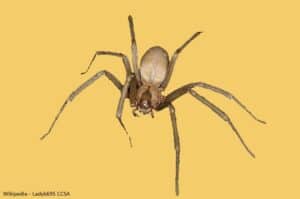Question by Hearts Pest Management for Entomology Student and Professor
For many years now, I (Gerry Weitz), have been fascinated by mites and the way they impact those prospective customers that I need to address. Recently, I noticed that my son’s friend had an academic concentration in the field of entomology. So I posed the following question to him and I also received a response from his professor. (I have not identified their names because it would be unfair to them to be flooded with calls that would distract them from their work.
Question: “I see you have some exposure to acari (mites). I was wondering. What are those things that signal attraction for acari food sources. I have an interest in mites. I have seen how they trail like ants (though they are acari) en mass to a food source. While some people when claiming mite bites clearly appear to be in a state of parasitosis, I have also found visible mites seem to be attracted to people on hormone therapy of one sort or another, or people with elevated hormone levels. My first case was a pregnant woman who had an outdoor aviary with about 15 infested parakeets. The mites left the birds and traveled 50 ft over and up to a second story bedroom to attack this woman. That does not jive with standard wisdom that mites will prefer birds. Why a pregnant woman? Since then I have had an abundance mite infestation reports from women on replacement hormones and also thyroid hormones. And one teenage boy on growth hormone.
Are mites attracted to certain hormones that they can detect. I think so. Any studies on these types of attractions. Do your professors have an opinion on this?”
Responses from Entomology Student and Professor working with Acari (mites) Regarding Host Hormones and Attraction
Student Response:
“From the information I have been presented with in class I believe the primary means of locating their host with regards to ectoparasitic acari species is through olfaction and gustation via karimones.
These Acari forms have a large number of sensilla (sensory hairs) that are arranged around the periphery of their mouth parts, all over their bodies, as well as along the entire length of their leg segments generally.
The sensilla located on their mouthparts as well as those on their legs specifically (tarsal segments) I would consider the most direct means of successfully finding a host.
-sensilla on mouthparts: through olfaction and gustation signal chemically to the acari form the presence of a food source from the host (i.e. epidermal cells, hair/fur, blood, feces etc.)
-sensilla on legs: can sense the environment in which they are standing (i.e. skin vs fur vs chitinous material etc.)
Through my own investigation I have found these common trends…
-in small mammals (mice), acari aggregation has been witnessed to be influenced by characteristics of the host in question.
example from one publication: aggregation of a tick species (Ixodes scapularis) was found to be correlated with specific physical characteristics within a population of mice.
-some of these characteristics include (gender, age, and mass)
– a direct correlation b/w mass and aggregation was witnessed in this study
example from another publication: high testosterone levels were believed to be the cause of increased feeding by another tick species on wood mice
-aggregation on the host is witnessed in specific regions where the acari form has a higher likelihood of protection from predation or environmental conditions
-acari forms DO communicate via pheromones: thus if a food source is found an aggregation pheromone may be emitted to recruit more member of the colony to feed
A few theories regarding the parasitism of the pregnant woman with parakeets include…
-perhaps traces of her (epidermal oils, skin follicles, hair, blood, etc.) were left on or near the parakeet themselves or their cages and thus that initial contact and availability to the parasites served as a reservoir for them to seek out and find entry into her room where she has been “attacked”/fed on.
-maybe if she was in close contact with the birds/cage a few acari forms were able to be transferred into her home via by attaching onto her clothes and thus because of their rapid generation rate and ideal conditions w/n her home a colony was generated.
-I´m sure you are plenty experienced with the correlation of higher infestation with decreased sanitary conditions: perhaps her sanitary practices are simply not adequate
-Finally, being that some of these acari forms (ticks and mites) are blood feeders it would not surprise me in the least that hosts with specific physical conditions would be more susceptible to parasitism
example: pregnant women or those on hormonal treatment may be a primary target for feeding due to over activation of their endocrine systems (hormonal release) which will change the concentration of their blood to be more favorable for feeding (i.e. higher concentrations of nutrients for development, oxygen, H20, etc.)
-this parallels aggregation and host seeking witnessed in mosquitoes to higher concentrations of C02 emitted from their host´s breath
-I am not sure specifically what hormones may cause this behavior but it would make sense that specific chemical structures at the molecular level that are consistent regardless of the hosts condition would show a trend in behavioral modification of the parasite.
ex: if the physical conditions your customers/”hosts” are in elicit a higher probability of for example (hair loss, skin flaking off, blood clotting etc.) then I can see a possibility of a greater likely hood that they would be a target for parasitism.”
Further response by Professor:
“Vertebrates do influence their acari via immune system involvement and related aspects such as skin inflammation, and those can be somewhat specific to body regions. This then could influence ectoparasite numbers by forcing them to select suboptimal (e.g. more easily groomed) body regions. Similarly, testosterone in males tends to have a cost to the vertebrate via suppressing male immune responses and helping the parasites. Ditto other stress hormones like adrenaline. Body functions can be closely interlinked; anything that influenced host immunity (e.g. other endocrine changes) or things like skin condition could impact the ectoparasites. Northern fowl mites are worst on hens as they enter puberty.
More to your exact question, other than the testosterone etc. thing above, I am not aware of acari responding DIRECTLY to host hormones per se. However, it wouldn’t surprise me very much. Fleas definitely respond to hormones related to host pregnancy (e.g. rabbit fleas) or sometimes to seasonal changes in host physiology (e.g. annual reproductive cycles in some rodents). I would recommend you look at the Sonenshine books on tick physiology.”
For Help with Mites
Read more about our Mite Extermination and Removal Services


